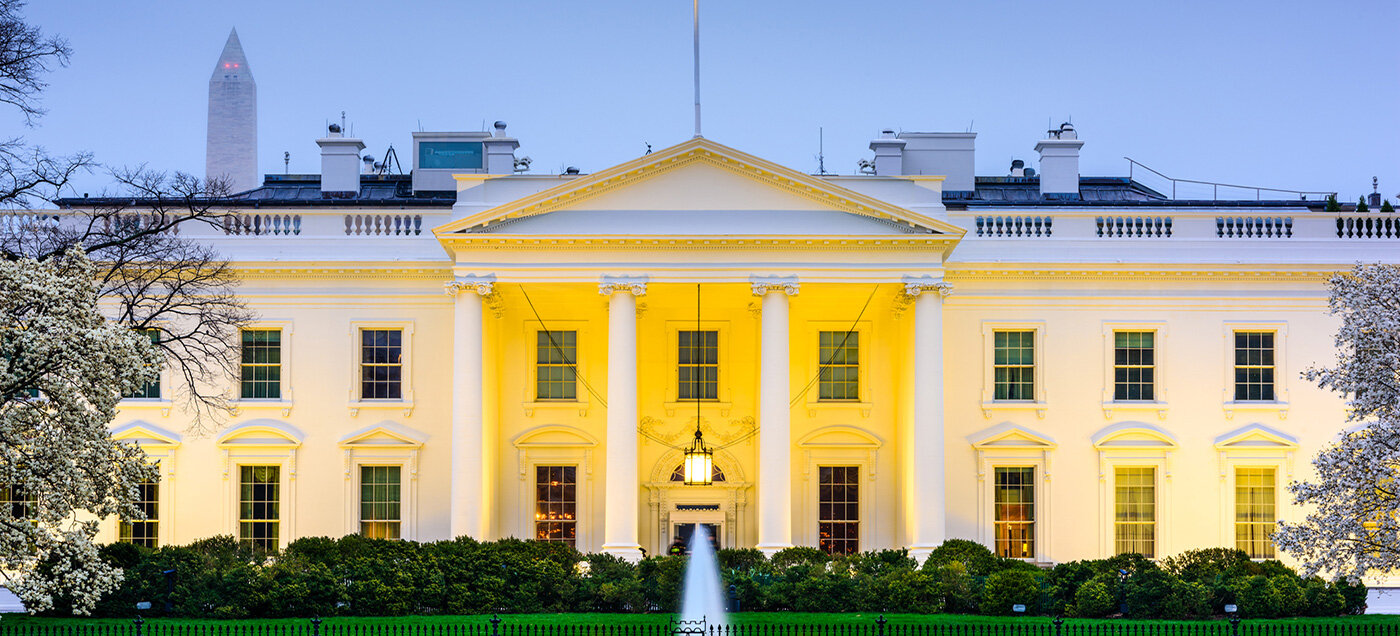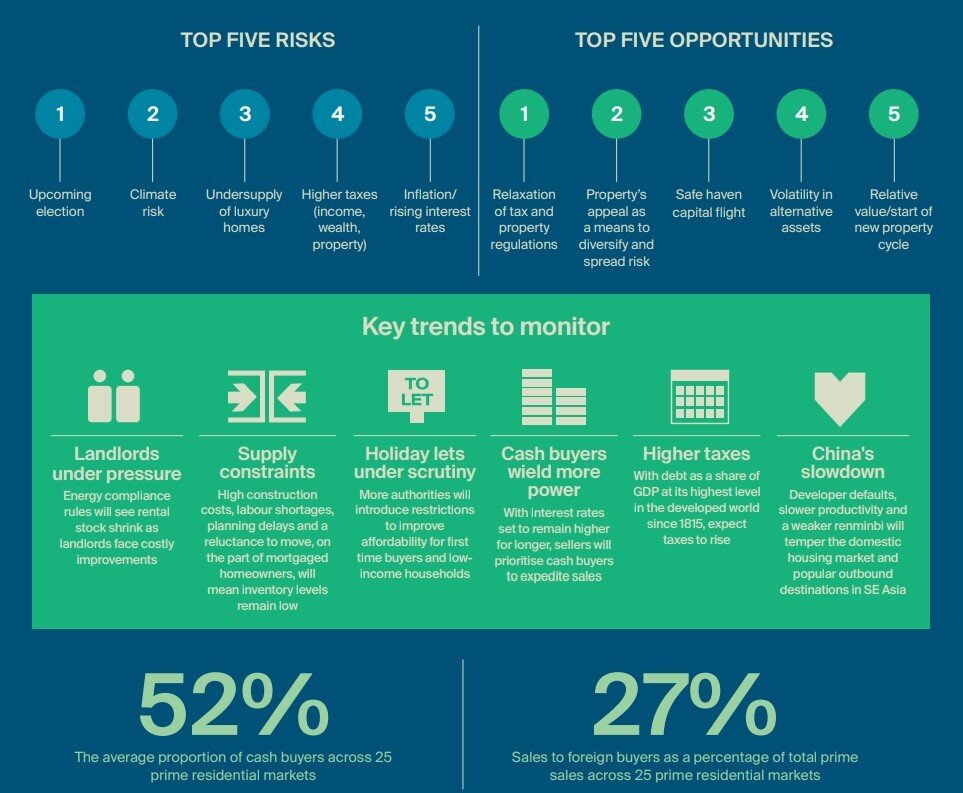Residential Real Estate News

2024 Elections Rank as Biggest Potential Risk to Luxury Housing Markets Worldwide
Residential News » Washington D.C. Edition | By Michael Gerrity | December 8, 2023 9:28 AM ET
Climate change ranked second biggest luxury housing market risk in 2024
Based on new data by Kate Everett-Allen, head of international residential research at Knight Frank, despite 2 regional wars, rising mortgage rates and inflation, global economies have displayed surprising resilience, with recent inflation figures suggesting a turning point.
While two major geopolitical crises unfold, presenting human tragedies and potential global economic implications, astute observers note varying approaches among central banks. Leaders in Canada and the UK have signaled their intent to address inflationary risks linked to higher oil and gas prices. In contrast, counterparts in Europe and the US appear more relaxed in their stance.
Amid this backdrop, the 'higher for longer' trend persists, leading to a notable shift in buyer behavior. Knight Frank's global research network reported that 52% of prime buyers are now opting for cash purchases, an increase from 46% six months ago.
Governments are grappling with mounting challenges, as public debt in the affluent world reaches historic levels relative to GDP, surpassing post-Napoleonic War figures, as reported by The Economist.
The inevitable consequence appears to be rising taxes, with policymakers likely to target property and wealth.
In the face of these headwinds, our overall prime price forecast for 2024 has grown from 2.1% to 2.5% since our mid-2023 global research team assessment.
However, the outlook for 2023 has seen the biggest improvement. At the midpoint of the year, our researchers projected a 1.7% average price increase. However, with just a month remaining, this figure has surged to 2.4%. What drives this positive shift in outlook? Some prime buyers appear confident that the worst is now behind us. On the demand side, with inflation receding and interest rate hikes entering their final chapter, buyer appetite has strengthened in some markets. Meanwhile, on the supply side, we're seeing a reluctance among mortgaged households to move, plus, high construction costs, persistent labor shortages, and planning delays are collectively contributing to a shortage of new stock entering the market.
Ups and Downs
A lot has changed since Knight Frank took the pulse of key city markets in mid-2023.
Singapore has ramped up stamp duty for nonresidents taking total purchase costs to around 60%, Hong Kong has moved in the opposite direction, New Zealand's change of government may yet mean rules for foreign buyers are relaxed, Los Angeles has introduced a mansion tax, whilst New York's authorities opted for a de facto ban on short-term lets.
Yet, despite the constant policy changes, alongside economic uncertainty and heightened geopolitical risk, prime prices have held up.
Kate Everett-Allen, head of international residential research at Knight Frank says, "While persistent inflation poses a potential threat to delicate buyer sentiment, the advent of new property cycles is expected to entice opportunistic buyers."
2023 Performance Data
In the 2023 rankings, Dubai emerges as the leader, anticipating annual growth of 14% over the full 12-months. Madrid (6.5%), Stockholm (5%), Seoul (4.5%), and Miami (4%) round out the top five, each city is either rebounding from recent price declines or experiencing robust wealth migration.
The landscape of slower price growth looms on the horizon, courtesy of the elevated cost of debt. While persistent inflation poses a potential threat to delicate buyer sentiment, the advent of new property cycles is expected to entice opportunistic buyers. These investors are likely to seize the initiative, exploring new locations and diverse property sectors.
Among the 25 cities tracked, Auckland emerges as the front-runner for 2024, anticipating a robust 10% increase in luxury prices. Contextually, this surge is best understood as a market correction, compensating for a previous peak-to-trough dip of 20%.
Dubai, last year's leading city, claims third spot in 2024 with projected prime price growth of 5%. After its stellar post-pandemic performance, the rate of price growth is slowing, but a scarcity of new prime supply and renewed demand from pivotal markets like China and India will see it remain in positive figures.
Madrid (5%) and Stockholm (4.5%) shine as Europe's highest-ranking cities. Attracting attention for their combination of good value, low purchase costs, a high quality of life, and no restrictions on overseas buyers, both cities are poised to garner increased interest.
Prime central London (0%) is poised for a milder correction compared to the broader UK market. This resilience is attributed to a higher prevalence of cash sales, particularly within Zone 1, coupled with prices currently sitting 15% below their previous peak.
According to Knight Frank, elections rank as the biggest potential risk to prime markets worldwide in 2024, with the relaxation of tax and property regulations considered the biggest opportunity. Here are the 5 biggest luxury housing market risk factors for 2024:
- 2024 elections
- Climate risk
- Undersupply of luxury homes
- Higher taxes on the wealthy
- Inflation and rising interest rates
Sign Up Free | The WPJ Weekly Newsletter
Relevant real estate news.
Actionable market intelligence.
Right to your inbox every week.
Real Estate Listings Showcase
Related News Stories
Residential Real Estate Headlines
- Las Vegas Area Home Prices Uptick 4.3 Percent Annually in March
- Single-Family Rent Growth in U.S. Trends Upward in 2025
- U.S. Mortgage Rates Tick Down Post Trump Tariffs Commencement
- President Trump's 'Liberation Day' Tariffs Potential Impact on the U.S. Housing and Mortgage Markets
- Baby Boomers Biggest Cohort of U.S. Home Buyers in 2025 as Millennials Decline
- U.S. Monthly Housing Payments Hit Record High in 2025
- U.S. Pending Home Sales Uptick in February
- Global Prime Residential Rent Slowdown Continued in Late 2024
- Ireland Home Price Inflation Hits 8 Year High in Early 2025
- Existing Home Sales in America Uptick in February
- Great Miami Area Residential Sales Decline 15 Percent Annually in February
- Mortgage Rates Uptick in Mid-March, Ending 9-Week Decline in U.S.
- World Property Ventures Builds the Future of Real Estate with New Funding Round
- U.S. Builder Sentiment Declines Amid Economic Uncertainty and Rising Costs
- Black Homeownership Rates in U.S. Enjoy Largest Annual Increase of All Racial Groups
- Wealthy Renters Are Taking Over More of the U.S. Rental Market
- If U.S. Congress Does Not Extend NFIP Soon, Thousands of Daily Home Closings Impacted
- U.S. Mortgage Applications Spike 11 Percent in Early March
- Greater Palm Beach Area Residential Sales Rise in Early 2025
- New Apartments in U.S. Are Leasing at Slowest Pace on Record
- U.S. Mortgage Rates Drop to 4 Month Low in March
- Overall U.S. Mortgage Delinquency Rates Dip in December
- New Tariffs on Canada, Mexico to Impact U.S. Homebuilder Input Costs
- Monaco's Property Market: A Tale of Two Cities
- U.S. Home Purchase Cancellations Surge, 1 in 7 Sales Getting Canceled
- U.S. Pending Home Sales Hit Historic Low in Early 2025
- Greater Miami Area Residential Sales Dip in January
- Governor DeSantis Supports Ending Property Taxes in Florida
- WPV Aims to Become the Berkshire Hathaway of Real Estate Tech
- U.S. Home Sales Slump Continues in January
- Average Americans Spend 38 Percent of Monthly Income on Mortgage Payments
- Switzerland's Safe-Haven Appeal Grows with World's Wealthy Homebuyers
- U.S. Builder Confidence Rapidly Declines in February
- Las Vegas Home Sales Rise 6.7 Percent Annually in January, Condo Sales Dip
- Homebuyer Demand in America Drops to 5-Year Low in Early 2025
- Ownership More Affordable Than Renting in Most U.S. Markets
- The World's First Global Listings Service Launches, Called a GLS
- Home Prices Continue to Rise in 89 Percent of U.S. Metros in Late 2024
- Global Luxury Residential Prices Showed Gradual Improvement in Late 2024
- U.S. Construction Hiring Rate Drops to Lowest Levels in 5 Years






